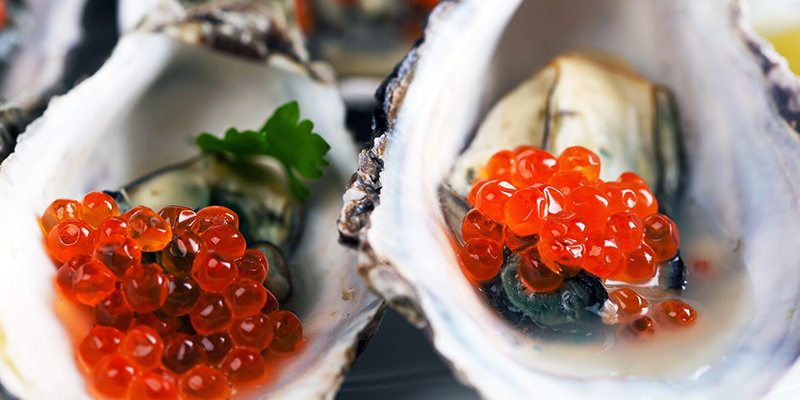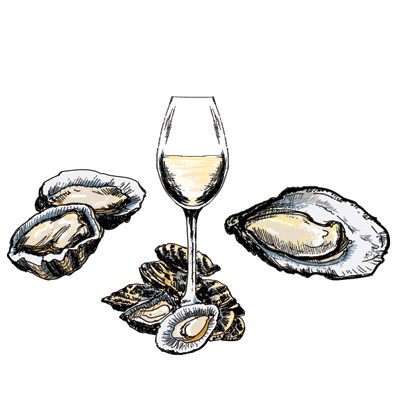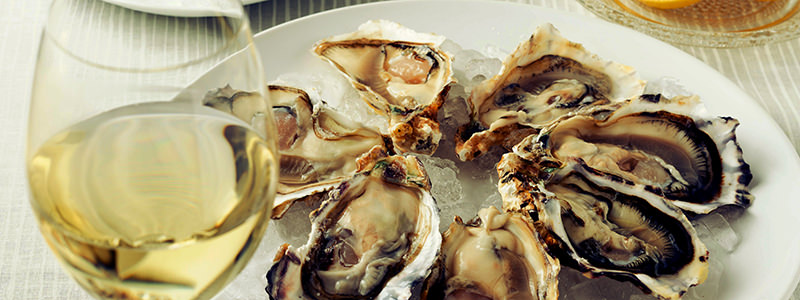Oysters are really one of nature’s most magical delicacies. They’re delicious, low in calories, and high in vitamins. Yes, the slimy texture and idea of eating something raw might be daunting to some of us, but there’s no reason you should be intimidated by these little mollusks, because they come in so many flavors and textures it’s hard not to find one you like. Do you prefer something briny, tough, and to the point? Then Long Island Bluepoints are for you. If you want something creamier and sweeter, Olympias are a safe bet. In fact, even seafood haters are in the clear since not all oysters are fishy. There’s truly an oyster for every palate.
 Another great thing about oysters is that along with wine, they’re often served as happy hour specials. Now that the sun is setting later and your boss is getting lenient about letting you slip out of the office early on Friday, try and catch a dollar oyster and wine special somewhere near you. Which wine, much like which oyster you should order, depends on your taste.
Another great thing about oysters is that along with wine, they’re often served as happy hour specials. Now that the sun is setting later and your boss is getting lenient about letting you slip out of the office early on Friday, try and catch a dollar oyster and wine special somewhere near you. Which wine, much like which oyster you should order, depends on your taste.
 If you’ve never had oysters before, it can be hard to determine what might be a good fit for you, but roughly speaking, East Coast oysters tend to be salty and chewy, while West Coast oysters have a more creamy, sweet taste. If you’re a major seafood junky and like the smell of the sea, East Coast oysters will suit you. If the idea of slurping an oyster scares you, West Coast oysters might be a better place to start. They’re usually smaller and richer than their East Coast counterparts
If you’ve never had oysters before, it can be hard to determine what might be a good fit for you, but roughly speaking, East Coast oysters tend to be salty and chewy, while West Coast oysters have a more creamy, sweet taste. If you’re a major seafood junky and like the smell of the sea, East Coast oysters will suit you. If the idea of slurping an oyster scares you, West Coast oysters might be a better place to start. They’re usually smaller and richer than their East Coast counterparts
Because of their briny toughness, East Coast oysters, like Bluepoints, Malpeques, and Duxbury go well with light-bodied wines with a bit of acidity, such Riesling, Prosecco, and Vinho Verde. If you’re more in the mood for West Coast oysters, like Olympias, Kumamotos, or Kusshis, try slightly heavier white wines such as unoaked Chardonnay, Sauvignon Blanc, and Cabernet Sauvignon rosé. While your oyster experience will vary with each wine, all of the ones we’ve listed have nice acidity that will cut well through the flesh of the oysters. If you’re not in the mood for any of those wines, no problem – simply try to pair bright, acidic wines with East Coast oysters, and slightly heavier ones with West Coast oysters. We don’t recommend red wines unless they’re particularly light bodied and fruity.
 While you’re welcome to eat your oysters and drink your wine however you’d like, we recommend the following: Tip the oyster shell into your mouth and suck out the contents. Then, contrary to popular belief, don’t simply swallow, first chew on the meat and taste the flavor. Now swallow and then take a sip of wine. The brightness of the wine will cleanse your palate and prepare you to try another oyster. Happy slurping!
While you’re welcome to eat your oysters and drink your wine however you’d like, we recommend the following: Tip the oyster shell into your mouth and suck out the contents. Then, contrary to popular belief, don’t simply swallow, first chew on the meat and taste the flavor. Now swallow and then take a sip of wine. The brightness of the wine will cleanse your palate and prepare you to try another oyster. Happy slurping!

